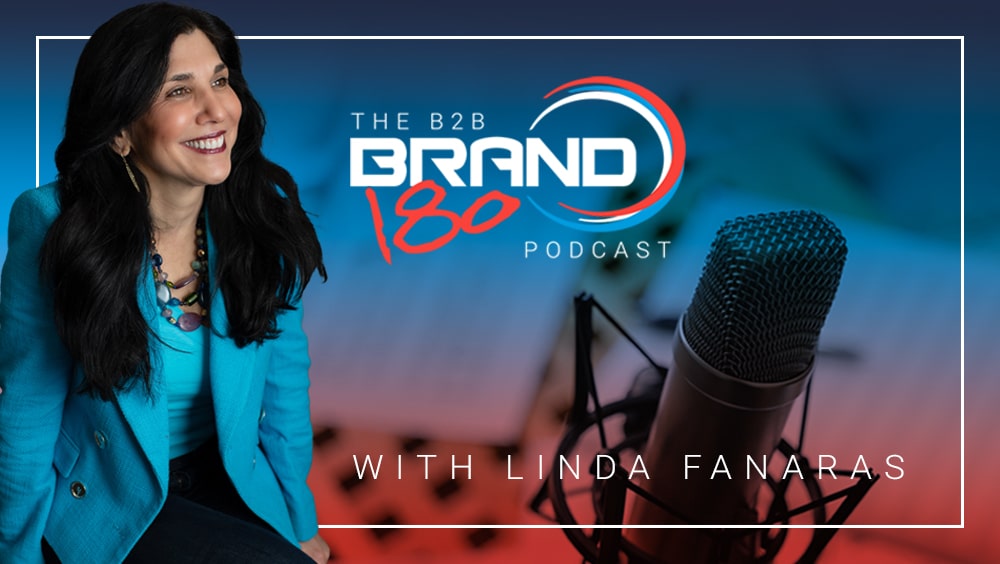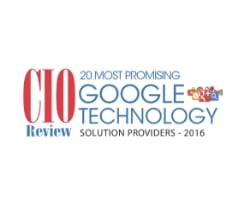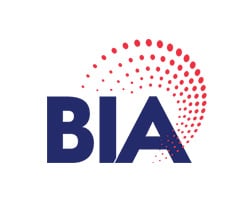In this episode of B2B Brand 180, Linda Fanaras interviews Tim Koelzer, the Managing Partner of Equibrand Consulting and author of ‘Upstream Marketing’.
Dive into the intricacies of upstream marketing and uncover how it helps drive conventional marketing tactics. Discover how a strategic upstream approach can fundamentally bolster your brand’s presence and impact.
Thanks for listening to the B2B Brand180 Strategy podcast with Linda Fanaras, CEO/Strategist at Millennium Agency.
Learn more about Tim Koelzer and Kristin Kurth’s book Upstream Marketing.
You can follow Linda at: https://www.linkedin.com/in/lindafanaras/
and Millennium Agency at https://www.linkedin.com/company/millagency/.
Linda Fanaras:
Hi, I’m Linda Fanaras, host of B2B Brand180 Podcast and CEO of Millennium Agency. If you want to transform your B2B marketing into a powerhouse brand, then you should listen in today. And if you like what you heard, simply like, share, or subscribe. Today, we’re going to talk to Tim Koelzer, Managing Partner at Equibrand Consulting. And he brings a substantial amount of expertise and knowledge in helping companies actually build their brand from a strategic perspective. Tim published a book called ‘Upstream Marketing’, and this is where he has shared some really great best practices around marketing, research, and he has shared some case studies as well and analysis, and Tim is going to speak to us today about how he helps companies achieve some of their goals and what he’s done. And also speak a little bit about his book. So, Tim, we can get started. Maybe take a couple of minutes and tell us a little bit about yourself first.
Tim Koelzer: 0:57
Thank you very much, Linda, for providing this opportunity. I love your show, as I just mentioned to you. So I’m really looking forward to be a part of it. I’m Tim Koelzer. I work for a company called Equibrand Consulting, which we launched about 20 years ago. More recently, we published a book called Upstream Marketing, which is really kind of a culmination of everything we’ve learned, both studying best practice companies as well as working with existing clients. And so we kind of bring that to bear and we’re a small firm. We’re kind of a boutique firm. We’re out of the Bay Area and our focus is really an upstream marketing, which I know we’ll talk some more about today.
Linda Fanaras: 1:29
That’s fantastic. And, you know, I love talking to other marketers, especially ones that actually own either strategy firms or digital marketing firms, because I love to learn about how different companies differentiate themselves, because often they talk about marketing companies and branding companies being like a commodity, like we all offer very similar services. So how are you different than others?
Tim Koelzer: 1:52
That’s a great question, because we really are pretty different, and we agree as well that marketing is so much about differentiation. We focus primarily, or actually almost exclusively on what we call upstream marketing, which is really a lot of the Work that would proceed working with like an advertising agency. So the work that we do is what we call upstream, which more about the marketing strategy aspects. You need to have both upstream marketing as well as downstream marketing. A lot of people, when they think about a brand strategy firm or a marketing strategy firm, they think about things like, like, like SEO or pay per click or website or advertising. We, we appreciate all that stuff, but we don’t really focus there. Our focus is the work that goes in front of that, what we call downstream. Both are absolutely necessary. And they need to go hand in hand, but our focus is more on the upstream. So we don’t do logo developments or website developments or advertising. We do the strategy and the planning that goes into those services.
Linda Fanaras: 2:46
That’s a really good take on something that’s a little bit different as far as where you’re, what you’re, how you’re niching that out. And I think that that’s an important part. So when we today, when we talked to the marketers, they all have different needs. And what I’m hearing a lot is that we want to generate leads. We want to generate sales. That seems to be their big focus. And, and building a brand is a huge part of that because if you don’t have a solid brand and if you don’t have key messaging that really ties into, your overall product or service offering, it’s hard to. Build interest in your sales funnel. How do you tackle that? How do you work with clients to address some of those needs?
Tim Koelzer: 3:26
Well, you know, right now, some of the biggest challenges facing a lot of marketers, there’s saturation, digital content increased noise, increased marketplace, people have compressed budgets, there’s rapid technological advances. So we do try to step back. What we’ve done as part of our work is we have a kind of a system we find we’ve studied a number of companies over the years, specifically in a book, we did kind of a best practice profile of companies that many people think about Amazon, Apple, Google, Nike, Starbucks, Southwest and the Walt Disney Company. And so. We took a step back and said, Well, how do these companies that everybody points to grow? Is there a set of principles or a process that they actually undertake that we can help our clients with? So we’ve defined a set of principles, insight, identity and innovation. Those kind of the three core principles that most companies need to. adhere to. And then a set of best practices that companies really need to follow to help grow. And it’s certainly challenging times. But if you take a step back and you have a systemized approach through growth, we find our clients are most successful in kind of that structured approach to growth.
Linda Fanaras: 4:33
Yeah. And I think that’s a great point because I think what CEOs of companies What they’ll do is they’ll try different strategies and they’ll decide, okay, that doesn’t work or this doesn’t work. And, but they don’t really realize that marketing is a cumulative process. And it is about finding what works and what doesn’t work, but it’s also about making sure you’re always piloting and testing opportunities that are out there to see what really does, line up with your business strategy and your lead generation plans. So I think those are all kind of key components. I like how you touched on that for sure. If you had some clients that you were working with that wanted to maybe expand their product line through some strategies and they’re feeling like, Oh, we don’t have much of a budget, but we need to grow. Do you have some initial thoughts or how you go about tackling that with some of your clients?
Tim Koelzer: 5:22
We typically would start with a internal audit. Every client situation is different. But we get in there and see are there opportunities to free up some dollars because you’re right, there’s limited funds and you can’t all of a sudden launch a new growth effort because you’ve got the bills to pay and getting the word out and some of the downstream activities. So we normally would start with a kind of an internal audit to see are there places. Where there might be some efficiencies gain. What are you doing right now to think about growth and new products and new offerings? Take a look at maybe the brand architecture, you know, how are you currently supporting your brands. it’s expensive to create a brand. You have too many brands. Are there ways to free up some dollars and part of the marketing to focus in other areas? Because you really do have to focus both on the upstream as well as the downstream. And people get caught up in, you know, the day to day firefighting and getting the word out that they forget to step back. And any entrepreneurs, as you know, an entrepreneur yourself, when they start, they think about all these things. Who am I going to target? Who is my segment? What segment? What target? positioning with some messaging, then they get tied up in the business. So we help them kind of step back and rethink, the old adage of working on the business versus working in the business, you need to work on the business as a leader in particular and identify those, those future growth opportunities.
Linda Fanaras: 6:39
Yeah. And I think as an entrepreneur, you’re always looking for the next idea that can help you grow. And it might not technically line up with what your initial plan was as a company and to your point, time passes and you’ve made all these. changes. And we find this with even brand managers is that they make go off onto these other tangents. And before you know it, they’re marketing execution doesn’t even line up with their actual original brand plan and strategy. So, I always think it’s important to keep in mind, who are you? What is your brand? What is your message? And then how you, and what are the markets that you’re going to go after in order to get that out there in a more, as systematic way as possible. And then making sure to your point is always kind of backtracking and saying, okay, are we still on target here? Are we still achieving the goals? You know, or are we getting off the rails off the rails here? And I think those are the types of things that companies really do need a consultant to help them stay on track. And I think that’s where that’s where you guys come in. Where do you see the biggest areas that you can help companies grow? Are there certain things that you have found that have been very successful in helping companies grow?
Tim Koelzer: 7:51
Yeah, I mean, we kind of a principled approach to growth. The first thing is we always start with the customer, and some of these are the principles that are in the book, but maniacally focus on the end customer, put customers first and look the business through their eyes. So there’s an orientation. Looking at the business from the eyes of the customer. And the second aspect is defining that core purpose. Cause as you suggested, you have to have kind of a guiding light or a beacon. So we help clients define a core purpose helps them define their playing field, which really then begins to scope up business opportunities. And then we have a framework of to whom are we speaking to. With what particular offering. So it’s a way of mapping opportunities through like a customer segmentation. The third step then is to develop winning value propositions at the company division or product level, really understanding what the needs of the customers are and translating that into actionable product plans. Then it’s defining a brand positioning as, as you very well know, you know, how do we elevate the brand to the highest levels of the organization and then develop You know, positionings that resonate in the marketplace, then it’s, innovation is is another focus. How do you provide a consistent stream of innovation over time, supported by a flexible test and learn approach? I think that’s the thing you talked about as well. Just mentioned, it’s you don’t always know what’s going to be successful. So to get out. Marketplace with opportunity areas is a way to do it. And that’s what Amazon does. They have the process called working backwards where it’s like, let’s define where we want to be in two or three years conceptually, but in a fair amount of detail and then define a plan to get there and make sure that it’s rooted in the customer needs. Then the final component is the final principle is one we call aim them, don’t tame them, which is you need to provide the structure and the process discipline, but you also want to provide your people. With the latitude to make mistakes, to grow, to be creative, to take some risk. And if you do all those things well that really sets you up for success with upstream marketing and longterm growth.
Linda Fanaras: 9:46
I think that’s a great point. And just sort of to back up a little bit when you’re talking about building out the messaging arc, and figuring out the pain points are and what your customer segments are and so on and so forth. I think companies need to realize, especially with manufacturers or tech companies where they’re dealing with different sectors, you’re dealing with different audiences and they need to speak to those audiences in the most effective way. So we always encourage our, our clients to figure out, To really sit down and profile, like, who are they speaking to? What is the language? And what does a messaging architecture look like for those target markets? And start to build that out based on whatever your product is, whatever the market is that you’re going after. And then also, what is the language that they speak? Because you don’t want to use generic language across multiple sectors. Otherwise, it just doesn’t resonate. It doesn’t work. Especially today where we are flooded with so much data, to your point, and everything’s coming at us at a very quick pace. I think it’s important to keep in mind that you really have to get a little bit more narrow and niche in your communication and be more personalized in your communication. Otherwise, you won’t be able to cut through a lot of the clutter that’s out there today. So we like to make sure that our clients and I’m assuming you do too, have that messaging architecture down and that that’s built out in a way that’s very effective and that they can use that as, as a guiding post to their, for all their marketing and efforts. So I totally agree with that.
Tim Koelzer: 11:17
Yeah, I think that’s very true, particularly the B to B spaces. As you well know, historically, a lot of marketing grew up in the, packaged goods like Procter and Gamble. You had one single unique selling position, which is still very important. But in B to B, it’s a more complex sale and there are more benefits that companies potentially are interested. So you really need to be thoughtful about, https: otter. ai Hey, there’s so many considerations. We want to be more effective in our messaging and really identify that core position in your unique selling stuff, but then promote it, you know, different messages that kind of tied to that, but can expand the value of the offering is, you know, brand like to think of brand values, what you get for what you pay, pay is, is fixed. So what you get, you know, you can, you can really dial that up through effective messaging and that messaging architecture where you’re identifying different marketing segments and then specific messages that resonate with those targets.
Linda Fanaras: 12:14
And I like the point that you made on innovation because I think that that’s a key point that companies, I don’t want to say they forget about it, but they don’t look at that as part of their marketing strategy. So whether that innovation, it could be something as adding a proprietary process. to their product or to their service line, or it could be something as simple as creating a product line extension or developing a new product. I mean, there are so many opportunities for new business growth that I think companies also need to put that into the mix. Otherwise they stop innovating and they stop thinking. I mean, Amazon’s a separate example because they’re always innovating like Apple and other large entities like that. But if you’re looking at a small to medium sized company. To your point, they get so into the weeds that it is so difficult to just take a step back and say, okay, what else can we be doing? What’s happening in the market? What are some of the emerging trends that are out there that we might be able to leverage for our own company growth? And how do we take advantage of that?
Tim Koelzer: 13:15
Yeah. I mean, just to, just to kind of Piggyback on that, we find the strongest companies take a portfolio approach to innovation. So they’re balancing incremental innovation, you know, like improvement, like the next iPhone generation, that’s incremental. There’s substantial innovation, which is extending beyond the court of new markets or new segments. So in the case of Apple, that would be like Apple music. And then there’s transformational where, you know, the Apple, the new vision pro or the apple phone. So it is helpful to think about innovation in a structured way and make sure that you’ve got certain things going on. In each of those. And you want to have a continual stream of innovation, much like apple does or amazon does every year.
Linda Fanaras: 13:56
So before we go to our next question, I just want to take a moment and thank our audience for listening in today. We really appreciate you supporting our channel and if you actually do enjoy what you’re hearing, we appreciate it. If you take a moment and just either like or subscribe or share to any of your colleagues and friends and that would be great. So, we’ll just move along to my next question, which I’m really curious about is, do you have some, maybe some stories, that you could share relating to some results that you’ve seen or that you helped your clients achieve?
Tim Koelzer: 14:27
Sure. Yeah. The one example would be if you probably remember the Hyundai many years ago and then more recently, they’ve, they’ve launched the Genesis brand. We’ve been a consultant to Hyundai for some time and Hyundai was an interesting product when it initially launched in the U. S., I don’t know, 25 years ago, it was launched as a very low cost product, maybe 500. I think it was the lowest at the time. It was like under 5, 000. You could buy a new Hyundai. And they launched and they had some very negative quality problems. And they were lingering quality problems because it takes some time to build a brand. And we assisted Hyundai when they were trying to come out of this bad quality metric and identify. You know, what do they want the brand to stand for? And what, how do they, how do they get through to the consumer? So we actually did an effort the study, we didn’t do the study, but they did some market research where they had the Hyundai car. They make a great car, by the way, and they’ve been making a great car for a number of years, but the image was always lagging behind the car. Mm-hmm. And so they actually took consumers out and said, here’s a car. they covered up all the branding icons, like the little front and all the identifiers in the car. And they asked consumers what they pay for that car. And consumers said, you know, 25, 000. Then they had another set of consumers and they did the same thing. But in this case, they had all the Hyundai logo and brand identity imagery on the car. And they said, like, you know, like 20, 000. So they actually had negative brand equity. You know, they would pay 25, 000 that was unbranded and 20, 000 if it was branded. So that’s the inverse, obviously, but where you want to be. And we do, we do studies with other clients where it’s like, you know, there’s brand value, they’re getting brand value. So the whole, how do you define brand value? Then it all goes back to, you know, customer segmentation, selecting the right target, developing a distinctive positioning and then getting certainly the word out into the marketplace. So, you know, we use a methodology methodological process to get through there, but it’s really a recognition how important that brand value can be because that that that relates to the bottom line. In the case of honey, they were actually losing money for the brand. And then more recently they’ve been tremendously successful. The brand has finally caught up. from where, from where it was to where it should be. And then, then they recently launched the, the Genesis brand several years ago, we were the, we were the consulting firm behind that launch to help define the brand position, developing a new luxury vehicle and bring it to the market. So that’s some of the work that we’ve done over the years. And we work in different categories. We tend to use consumer products with people. Everybody knows what a Hyundai is or an Acura. But our work is in, medical devices or pharmaceuticals or insurance or financial services. But the principles of effective, you know, marketing strategy, upstream marketing, brand management are really the same across categories we find anyway.
Linda Fanaras: 17:23
So when you’re working with clients, I think, especially when you’re working with maybe the small to midsize clients, they’re always interested in those fast, short, quick gains. And a lot of, I think the work that we do takes a long time, you know, and how do you, how do you balance
Tim Koelzer: 17:40
that? Yeah, it’s tough because you’re absolutely right. We just try to, demonstrate how these larger companies and successful companies do things. And we do pull in a fair number of best practices because, you know, Amazon or Apple didn’t build their business on, SEO or pay per click or their website or advertising business. I’m listening to the customer. defining opportunities and then growing from there. So a lot of it is education. You know, some of it is having said that a lot of these big companies, they can have a whole department, focus on everything tied to new products. So most smaller companies don’t have that luxury of, of having separate people because the best companies that do innovation have a dedicated staff because when you think about innovation and growth, you really need to consider that it’s not done the same way like incremental innovations. We talked about the differences between types of innovation. If you really want that longterm, transformational innovation, you have to really separate that from the organization. Ideally, you’re, you maybe have, you know, separate people working at, but you have to at least have things like strategy sessions and. And marketing strategy projects or concept development projects or new product development initiatives where you’re parceling that off and saying, this is separate, how we grow the business here in the new business space may be different from what we’re doing in kind of the existing business. So just mindset, and that’s why we separate upstream marketing from downstream marketing, just to have that orientation that both have to happen to be successful.
Linda Fanaras: 19:08
That’s a really, it’s a great point that you make, because I think when you’re talking about downstream and you’re talking about things like when you’re building a logo or you’re building a brand strategy and you’re building out messaging architecture and the client recognizes, okay, that needs to get done, but we need to generate revenue and we need to generate leads. Well, to do it right, you want to have the brand and you want to have the messaging straight. So I, it’s sometimes it’s a very challenging balance to, to make them, to get them to sort of understand How we need to get to be, but in order to get to be, we really need to get a done. Cause if, if we, you take too long, then, you know, they may not be happy. So there’s gotta be some tactics and strategies to get them some initial sort of lead generation and sales opportunities while at the same time working on brand development and the logo. So I like how you split that up because I think it helps. You differentiate it and it helps them focus on just one aspect of marketing because there are so many different aspects of it.
Tim Koelzer: 20:11
Yeah. Yeah. Marketing almost needs to market itself, you know, because you said there’s so many, you know, there’s, you know, there’s content marketing, digital marketing. You can probably name a dozen or more different types of marketing. So much focus and emphasis is there.’cause it, it makes the cash registers ring. Mm-hmm. And a lot of the upstream stuff, it’s, it falls into that quadrant of important but not urgent. You know, it’s like we can put that off to, to tomorrow or the next day. Or the next day. Exactly. So many companies just put it off almost indefinitely, so. Mm-hmm. you know, it’s really just to have that, that discipline and, and, And a lot of this, by the way, is writing stuff down. I didn’t really talk about that, but so much innovation is, is like, where’s our strategy? What are the growth? What are the strategic growth opportunity areas that, that are compelling for this business and how do we prioritize them over time? So we always have a list of stuff we’re working on and that ties to budgeting budgeting process, but just to write a codified manner. Really help organize. They say, Yeah, we don’t have time for that growth initiative today. That’s on the list, though. Let’s focus here. So this is just the discipline of a systemized process.
Linda Fanaras: 21:24
Yeah. And I was going to ask you about a customized plan, which you just, you know, spoke a little bit about as you’re building out these ideas and strategies for the clients. But I think it’s also important for clients to take advantage of consultants like yourself because you can help them pick and choose what works and what doesn’t work. Because I think for a CEO, it’s a little bit of a guessing game, but for a marketer, we’ve been doing this for, you know, years and years and years. So we do know what works and what doesn’t work. And that’s really where you can leverage expertise that you have, as a consultant.
Tim Koelzer: 21:56
Yeah, that’s very true. So, so much of this is just, you know, getting it out of the clients or the, but then getting, getting feedback too from customers. One of our, one of our our bias is many of the answers to marketing reside in the marketplace and so you need to get their feedback and you can do that through exploratory research, just sitting down with them, understanding their needs or pain points or benefits sought. Or through concept work, where concept work we do a fair amount of. They’re very simple concepts, but it’s just to say, here’s an idea this company’s working on. Here’s the headline. Here’s a couple of copy points, and here’s the benefit wrap up at the end. And so we expose these ideas to their customers in a one on one session or group session and say, here’s an idea this company’s, this company’s working on. Do you like the idea? Yes. No. Why? Why not? It’s good. It really, it takes a lot of research to the next level where you’re exposing them to new ideas, whether it’s a positioning idea or a new product idea or some other growth platform opportunity. And you’re exposing the ideas, getting feedback from customers and using that to help make the decisions when you’re speaking with the client, whether it’s a CEO or the marketing manager, whomever it may be.
Linda Fanaras: 23:04
So that brings me to my next question. How do you use data analysis and research, you know, in your process to help to help the clients? Are you doing it through interviews with their customers? Are you doing it through quantitative or qualitative processes? What type of research do you engage
Tim Koelzer: 23:22
in? Yeah, we do, broadly qualitative and quantitative. Within qualitative, there would be exploratory. Research, whether it’s focus groups or individual interviews, then quantitative research could be anything from market sizing, you know, the opportunity of concept development, testing the strength, you know, measuring the strength of our brand versus our competitor brand. Kind of the Hyundai example I mentioned earlier. So there’s so many methods, but we do, we’re very strong believers in the role of customer research. You know, one of the, one of the anchor questions we ask our clients is what do you know about your important customers that your competitors don’t know? So if you can ask that question, what do you know about your important customers? At first it defines, it makes you define who is that important. And then, you know, what, that level of insight that maybe they’re not, that they, that isn’t. And that everybody knows. So you really spend your time with customers so you can gain that level of proprietary insight into their needs. And that can often form the basis of competitive advantage. So if we have deeper insight into our customers, I mean, true insights and then use that insight to develop products or programs or promotions will be that much more effective. And so many clients, they, they don’t take the time. And this doesn’t always have to be a research study too. If you’re a small company, I mean, You know, you’re, you’re, you know, you’re a company that does like you look at Yelp or you look at social I mean, some of this stuff can be done. much less expensively, but it’s taking the tools that you do have and maybe it is looking through social listening. So there’s, there’s so much more interactivity now and certainly, you know, more of the detailed analysis, like click through analysis as well as other aspects. But a lot of it is just, having that orientation of, everything we do is different from the, from the eyes of the customer.
Linda Fanaras: 25:06
And my last question is, is, How are you always, and I know you talked about writing everything down and making sure you sort of look back, but how do you make sure that the strategies that you are implementing actually align with their overall vision and
Tim Koelzer: 25:20
goals? It’s a great question because, you know, we very much are believers in doing that and it really starts, you know, and so first off, it’s having that that clarity of definition of who are we as a company and whether you call it the purpose, or your mission, your vision, your values. That’s really where you start. And, and then once you have that, everything kind of stems from that. So at the back end, you shouldn’t have opportunities that are necessarily misaligned. But it may be though that, you know, you’re, this brand stands for something and you wanna identify that opportunity, but another opportunity comes way that’s inconsistent with the brand. And then you have to think, well, do we create a new brand or should we. say, you know, this is not consistent with who we are as a company. We’re not going to go after this initiative. So it really does that with that, with that, that overarching purpose or mission or vision. And you use that continually to screen ideas. So whenever we screen like a new idea or a new product opportunity, new service opportunity, we’re looking for four measures. Number one is meet the needs of the customers. Number two, operationally, can we, can we manage it? We have to do something different. Number three, financially, can we make money on it? And then the fourth one is strategically just a fit with who we want to be as an organization. So every product idea really needs to be screened through those four measures. Right. So that fourth one is really, maybe that’s the first one I would talk about with the order here, but you have to be, has to meet these customers has to be. You know, operationally consistent we can make money and it fits with where we want to go as an organization. So that’s definitely one of the screens that you’d apply against those new business opportunities.
Linda Fanaras: 26:58
So I, so just to wrap up, I’d love for you to share a little bit about your book, where they can buy it and how companies can get in touch with you and. Yeah. Learn more about your company. Go ahead.
Tim Koelzer: 27:11
This is the book. It’s available on Amazon. It’s available audio book too. I know a lot of business people are busy but it’s a great way to download audio books or or it’s available there. And then we do have a website upstream marketing. com. And then all of this really. Alliance with our business, which is ecobrandconsulting. com, which is where we do the actual work. So it’s really our two offerings upstream marketing, by the way, it was, it’s kind of a growth platform for us because we took a lot of our knowledge and use that as a platform for podcasts like this, or we’re trying to get the word out about, about our company. So it is really a growth initiative on our own. And we use a lot of the principles in the book and it’s based on. Profiling these 67 companies that I mentioned, we just do a really in depth dive and try to make it as actionable as we can. It’s principle based. So it’s particularly good for, you know, business, business, business, consumer, as well as large and small companies. So I think we think people, you know, wherever you’re coming from, you’ll get a lot out of it.
Linda Fanaras: 28:10
That’s great. I love talking to other marketing experts. So this has been fantastic. I always like to like. level up what we speak about when it comes to branding and messaging and marketing. And it’s always important to have individuals like you on the air to help do that. So I do appreciate that very much. I just want to thank our listeners today for listening in to a B2B Brand 180 podcast. And again, if you like what you heard, please feel free to share, like, or subscribe. And Tim, thank you again so much for your insights.
Tim Koelzer: 28:40
Thank you so much. Thank you. Bye bye. Bye
Linda Fanaras: 28:43
bye.





























